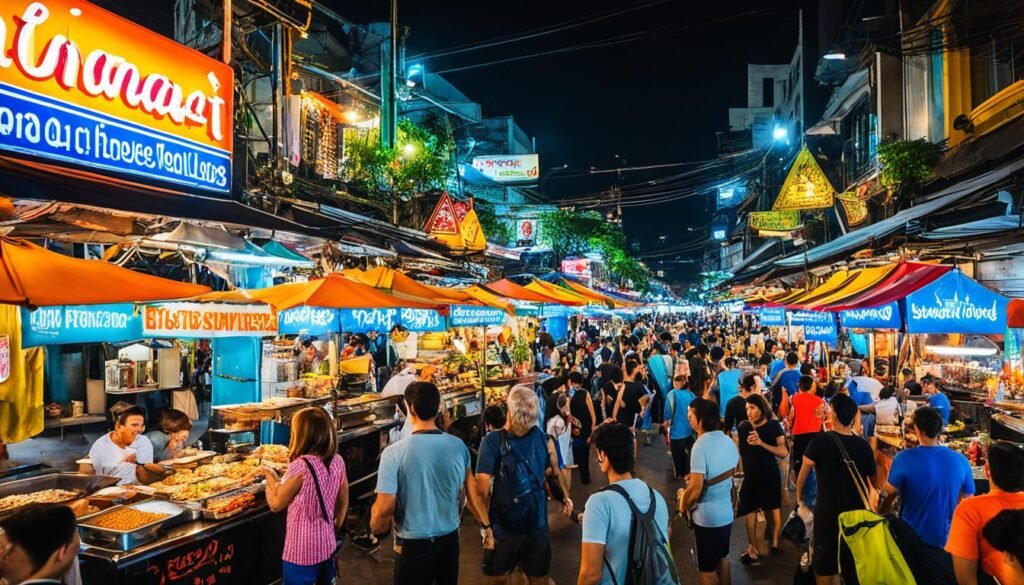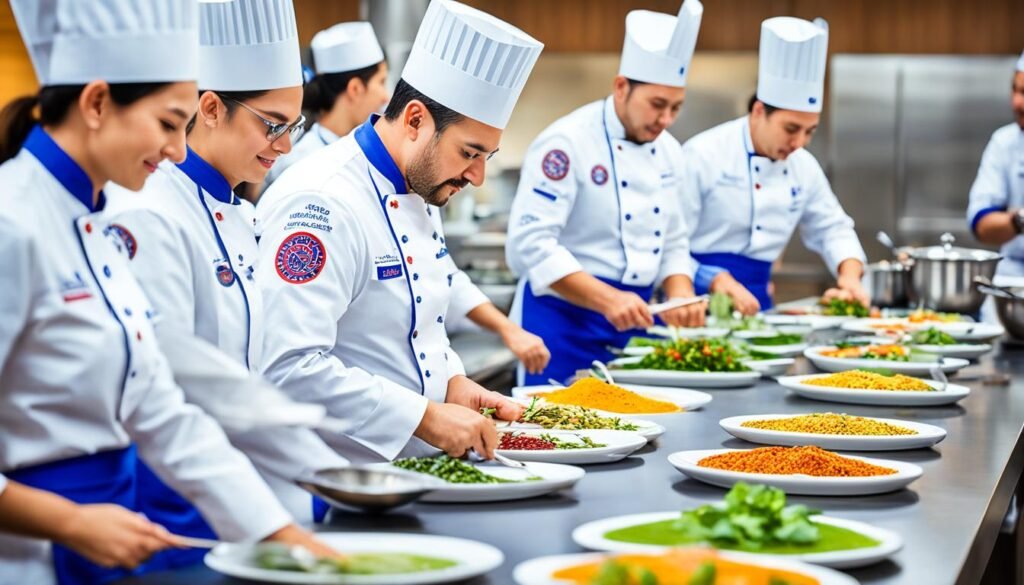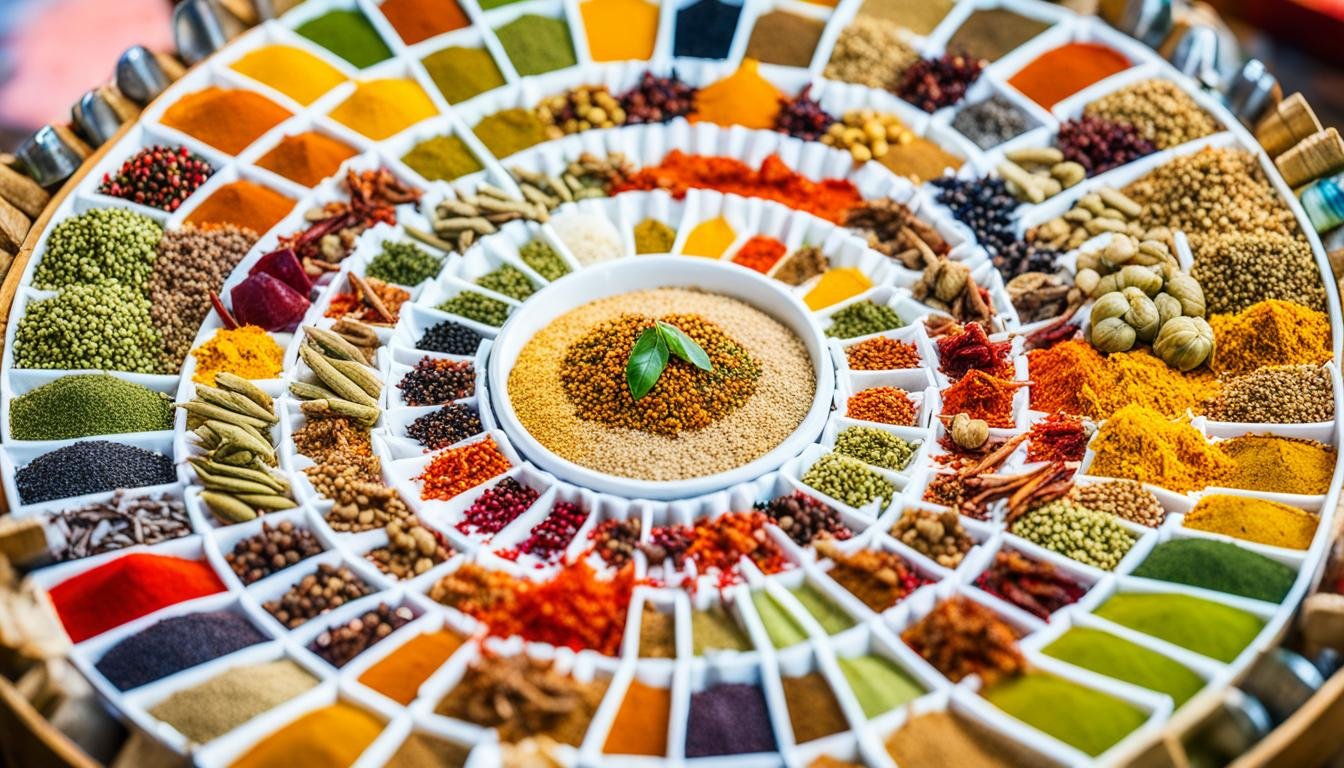Did you know that Thailand’s culinary traditions date back over 200 years? The country’s rich cultural heritage has given rise to a diverse and flavorful cuisine that has captivated the world. From the bustling streets of Bangkok to the remote corners of the countryside, Thai food is a profound expression of the nation’s identity, blending ancient cooking techniques with modern culinary innovations.
Key Takeaways
- Thailand has a long and storied culinary heritage that has shaped the country’s cultural identity.
- Thai cuisine is a harmonious fusion of flavors, blending sweet, sour, spicy, and salty elements.
- Bangkok, the capital city, is a vibrant hub of Thai culinary arts, offering a diverse array of street food and fine dining experiences.
- Thai cooking techniques, such as stir-frying and curry-making, are an integral part of the country’s culinary traditions.
- Authentic Thai recipes and dishes, from classic curries to delectable desserts, can be recreated at home for a true taste of Thailand.
Exploring Thailand’s Rich Culinary Heritage
Thailand’s culinary landscape is a captivating tapestry of regional flavors, each thread woven with the intricate cultural traditions that have shaped the nation’s diverse Thai cuisine. From the vibrant curries of the central region to the fragrant noodle dishes of the north and the seafood-centric specialties of the south, every corner of the country offers a unique gastronomic journey.
Thai Cuisine: An Exotic Fusion of Flavors
Thai cuisine is renowned for its delicate balance of sweet, sour, spicy, and salty elements, creating an exotic fusion that tantalizes the taste buds. The use of fresh herbs, such as lemongrass, kaffir lime, and galangal, along with a diverse array of chili peppers, imparts a distinct aromatic profile to Thai dishes. This harmonious interplay of flavors is a testament to the culinary ingenuity of the Thai people, who have perfected the art of blending ingredients to achieve the perfect harmony.
Regional Thai Dishes: A Gastronomic Journey
Exploring the regional Thai dishes is akin to embarking on a culinary odyssey. In the central region, the rich and creamy curries, such as massaman and red curry, are celebrated for their depth of flavor. The northern provinces are renowned for their fragrant noodle dishes, like khao soi, which blend Indian and Burmese influences. Meanwhile, the southern coastline offers an abundance of seafood-centric specialties, from spicy Thai curries with fresh fish to the iconic Tom Yum Goong soup. Each regional cuisine tells a unique story, reflecting the diverse geography, cultural influences, and local ingredients that have shaped the Thai food culture.
Bangkok: A Street Food Paradise
Bangkok’s vibrant street food scene is a captivating showcase of Thailand’s culinary traditions. The bustling streets of the city are lined with a dizzying array of vendors, each offering a tantalizing array of authentic Thai dishes that tantalize the senses. From the sizzling noodle stalls to the fragrant curry shops, the Bangkok food scene is a true gastronomic playground, where visitors can immerse themselves in the depth and diversity of Thai culinary arts.

At the heart of this street food paradise are the skilled Thai chefs and vendors, who have honed their craft over generations, passing down the secrets of their regional specialties. Whether it’s the mouth-watering pad thai, the aromatic tom yum goong, or the sweet and creamy coconut-based desserts, each bite is a delightful exploration of the rich flavors and textures that define Thai cuisine.
Beyond the familiar favorites, the Bangkok food scene also offers a glimpse into the lesser-known corners of Thai culinary traditions. Venture into the city’s back alleys and you’ll find hidden gems serving up regional delicacies, from the fiery northern curries to the tangy southern specialties, all crafted with the same unwavering dedication to quality and authenticity.
Thailand: Southeast Asian Culinary Arts Bangkok Thailand
The unique flavors of Thai cuisine are largely attributable to the abundant use of aromatic Thai herbs and Thai spices. Ingredients such as lemongrass, kaffir lime leaves, galangal, and fresh chilies are integral to creating the distinct Thai flavors that define Thai cooking and Southeast Asian cuisine.
Aromatic Thai Herbs and Spices
From the fragrant lemongrass that infuses soups and curries with a citrusy aroma to the warm, earthy notes of galangal, the Thai kitchen is a symphony of scents and flavors. The generous use of fresh herbs like holy basil, cilantro, and mint, combined with the subtle heat of chilies, creates a harmonious balance that is the hallmark of Thai dishes.
Kaffir lime leaves, with their distinctive aroma, are indispensable in Thai cooking, lending depth and complexity to curries and sauces. Equally important are the pungent roots and rhizomes, such as turmeric and ginger, which add vibrancy and warmth to the Thai culinary experience.
Mastering Thai Cooking Techniques
Crafting authentic and flavorful Thai dishes requires a deep understanding of the region’s rich culinary traditions. From the intricate process of making fragrant curry pastes to the delicate art of folding and shaping intricate Thai desserts, the secrets to Thai cooking lie in the mastery of time-honored techniques. Thai culinary skills involve a keen eye for detail and a commitment to preserving the distinct flavors and textures that define this vibrant cuisine.
At the heart of Thai food preparation is the careful selection and skillful blending of aromatic herbs and spices. Thai cooking techniques involve the precise balancing of sour, sweet, salty, and spicy elements to create a harmonious symphony of tastes. Whether it’s the rhythmic pounding of ingredients in a traditional mortar and pestle or the deft stir-frying of ingredients over high heat, each step in the Thai culinary process is imbued with a deep respect for tradition and a passion for the craft.

Beyond the fundamental cooking methods, Thai cuisine also celebrates the art of presentation. Thai food preparation often involves the intricate folding and shaping of ingredients, transforming simple dishes into edible works of art. From the delicate orchid petals adorning a fragrant curry to the intricate patterns carved into fresh fruits and vegetables, the visual appeal of Thai cuisine is as captivating as its flavors.
Mastering the techniques of Thai cooking is a continuous journey, one that requires patience, dedication, and a deep appreciation for the culinary heritage of this vibrant Southeast Asian nation. By immersing themselves in the nuances of Thai food preparation, home cooks and aspiring chefs alike can unlock the secrets to creating authentic and unforgettable Thai dishes that celebrate the country’s rich culinary legacy.
Authentic Thai Recipes for Home Cooks
Bringing the vibrant flavors of Thailand into your own kitchen is an exhilarating and rewarding experience. From the complexity of classic Thai curries to the beloved Thai noodle dishes, home cooks can now recreate the authentic taste of Thailand right in their own homes.
Classic Thai Curries and Noodle Dishes
Explore the depth of Thai curries, from the fiery red curry to the fragrant green curry and the rich, aromatic massaman. These Thai curry recipes offer a delightful balance of spices, coconut milk, and fresh herbs that will transport your taste buds to the bustling streets of Bangkok. Equally captivating are the beloved Thai noodle dishes, such as the iconic pad thai and the hearty khao soi, which showcase the country’s mastery of noodle-based cuisine.
Traditional Thai Desserts and Sweets
No Thai-inspired meal is complete without indulging in the delectable world of traditional Thai desserts and sweets. Savor the sticky, sweet, and creamy delight of sticky rice with fresh mango, or dive into the silky smoothness of coconut pudding. These Thai sweets provide a delightful conclusion to any Thai culinary experience, allowing you to fully immerse yourself in the rich cultural heritage of Thailand.
Whether you’re craving the bold flavors of Thai curries, the comforting satisfation of Thai noodle dishes, or the sweet indulgence of traditional Thai desserts, the recipes featured here will help you bring the essence of Thailand into your own kitchen. Embark on a culinary journey and discover the authentic tastes that have captivated the world.
Le Cordon Bleu Dusit: Culinary Excellence in Bangkok
Nestled in the heart of Thailand’s bustling capital, the Le Cordon Bleu Dusit culinary school stands as a beacon of culinary excellence. This prestigious institution, a collaboration between the world-renowned Le Cordon Bleu and Thailand’s Dusit Thani University, offers students a unique opportunity to master the art of Thai cuisine and international culinary techniques.
Programs and Courses Offered
The Le Cordon Bleu Dusit’s comprehensive curriculum caters to aspiring chefs and food enthusiasts alike. From the prestigious Grand Diplôme, which combines the Diplôme de Cuisine and Diplôme de Pâtisserie, to the specialized Diplôme de Cuisine and Diplôme de Pâtisserie programs, students can choose the path that best aligns with their culinary passions. For those seeking to immerse themselves in the flavors of Thailand, the school’s Professional Thai Cuisine program provides an in-depth exploration of the country’s rich gastronomic heritage.
Whether you’re a seasoned chef or a food lover seeking to expand your horizons, the Le Cordon Bleu Dusit in Bangkok offers a world-class culinary education that will elevate your skills and deepen your appreciation for the art of Thai cuisine.

The Thai Food Culture: Traditions and Etiquette
Immersing oneself in the vibrant Thai food culture is a captivating experience that transcends the mere act of dining. From the importance of communal meals to the reverence for high-quality ingredients, understanding the cultural nuances of Thai cuisine enhances the overall experience. Familiarizing oneself with traditional Thai table manners and serving customs can further deepen the appreciation for this rich culinary heritage.
At the heart of Thai food culture lies the concept of “Kreng Jai,” a deep respect for others and a desire to maintain harmony. This ethos is reflected in the way Thai meals are shared and savored. Dishes are typically placed in the center of the table, allowing everyone to collectively enjoy the array of flavors and textures. Passing food to one another and sharing bites is not only a practical approach but also a means of fostering a sense of community and connection.
The reverence for Thai culinary traditions extends to the preparation and presentation of the food. Thai cuisine is renowned for its skillful use of aromatic herbs, spices, and fresh, locally sourced ingredients. Chefs take pride in crafting dishes that balance the five fundamental tastes: sweet, sour, salty, bitter, and spicy. This harmonious blend of flavors is not only a culinary achievement but also a reflection of the Thai people’s deep appreciation for the art of cooking.
By embracing the rich traditions and etiquette of Thai food culture, diners can enhance their overall dining experience and gain a deeper understanding of this vibrant and dynamic cuisine. Immersing oneself in the communal spirit, respecting the culinary artistry, and familiarizing oneself with the nuances of Thai table manners can lead to a truly memorable and authentic Thai culinary journey.
Sustainable Farming and Thai Culinary Tourism
Thailand’s culinary scene is embracing sustainable farming practices and promoting agritourism in a unique way. Visitors can explore organic farms, learn about traditional cultivation methods, and engage with local communities to gain a deeper understanding of the connection between Thai cuisine and the land. This sustainable approach helps to preserve the country’s culinary heritage and provides opportunities for cultural exchange and economic development.
Sustainable Thai farming is at the forefront of the country’s culinary tourism initiatives. Tourists can immerse themselves in the rich agricultural traditions of Thailand, witnessing firsthand the production of essential ingredients used in iconic Thai dishes. From exploring organic vegetable gardens to participating in rice harvesting, these experiences offer a unique glimpse into the heart of Thai food sustainability.

The rise of agritourism in Thailand has also enabled travelers to forge meaningful connections with local communities. By engaging with farmers and artisans, visitors can learn about traditional production techniques, such as the use of Thai herbs and spices in cooking. This cultural exchange not only enhances the culinary experience but also supports the livelihood of these communities, fostering a sustainable ecosystem for Thai food and its traditions.
Thailand’s commitment to sustainable farming and culinary tourism has positioned the country as a leading destination for those seeking an authentic and eco-friendly gastronomic adventure. By embracing this holistic approach, Thailand continues to preserve its rich culinary heritage while also providing travelers with a transformative and meaningful experience.
Influential Thai Chefs and Their Signature Dishes
Thailand’s culinary landscape is shaped by a growing number of talented Thai chefs who are showcasing the depth and diversity of Thai cuisine. From celebrated restaurateurs to television personalities, these culinary innovators are captivating diners with their signature dishes and innovative approaches to traditional recipes.
One such chef is Gaggan Anand, whose eponymous restaurant in Bangkok has become a global destination for Thai food enthusiasts. Anand’s modern interpretation of classic Thai dishes, such as his innovative “Mango Lassi” curry, has earned him numerous accolades, including the coveted title of “Asia’s Best Restaurant” multiple times.
Another influential Thai chef is Duangporn “Bo” Songvisava, co-owner of the acclaimed restaurant Bo.lan. Known for her dedication to sustainable and locally-sourced ingredients, Bo’s dishes, like her signature “Gaeng Kua Nua,” blend traditional Thai flavors with contemporary culinary techniques.
Thailand’s vibrant food culture has also given rise to television personalities like Pailin Chongchitnant, who has captivated audiences worldwide with her engaging cooking demonstrations and exploration of regional Thai specialties. Her signature dish, the fragrant “Khao Soi,” has become a must-try for visitors to Northern Thailand.
These Thai chefs and food personalities are not only showcasing the depth and diversity of Thai cuisine, but they are also inspiring a new generation of culinary innovators to push the boundaries of traditional Thai flavors and techniques.
Conclusion: Embracing the Vibrant Flavors of Thailand
The captivating culinary journey through Thailand’s rich cultural heritage and diverse regional specialties has been a truly rewarding experience. From the bustling street food scene of Bangkok to the aromatic herbs and spices that define Thai flavors, the country’s enduring culinary legacy offers a testament to the unique and vibrant flavors of Thai cuisine.
Exploring authentic Thai recipes at home or seeking out culinary excellence at renowned institutions like Le Cordon Bleu Dusit has provided a deep appreciation for the intricacies of Thai cooking techniques and the traditions that shape the country’s food culture. Whether savoring the bold and harmonious flavors of classic Thai curries, delving into the world of traditional Thai desserts and sweets, or immersing oneself in the sustainable farming practices that influence Thai culinary tourism, the opportunity to embrace the diverse flavors of Thailand is a truly remarkable experience.
As we bid farewell to this exploration of Thai culinary arts, we are left with a profound understanding of the country’s rich cultural heritage and a renewed appreciation for the vibrant and captivating flavors that define the essence of Thai cuisine.
Source Links
- Top Degrees in Food and Beverage Studies Culinary Arts in Thailand for 2024 – https://www.educations.com/culinary-arts/thailand
- Culinary Arts School in Bangkok – https://www.cordonbleu.edu/thailand/home/en
- ALMA – The School of Italian Culinary Arts – Officially Opens Its First Flagship School in Southeast Asia at The Food School Bangkok, Thailand – https://www.restaurantnewsresource.com/article124566.html


